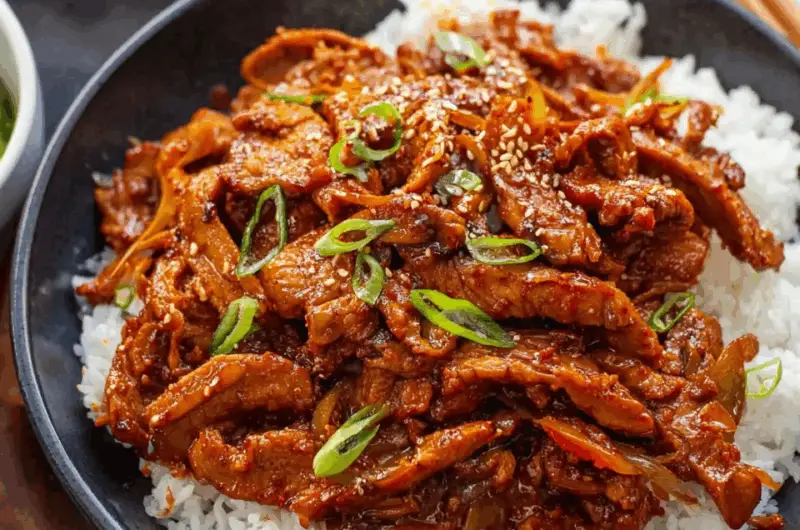Nutritional Values
These values may vary depending on specific ingredients used (e.g., soy sauce brand, pork fat content) and portion sizes.
The Appeal of Korean BBQ
Korean BBQ is more than just a meal—it’s a cultural experience. Traditionally, Korean BBQ involves grilling various types of meat at the table, and this communal experience is a beloved pastime. The method of grilling meat allows for a smoky flavor that complements the marinated ingredients. However, making Korean BBQ at home doesn’t require a grill. With this recipe for Korean BBQ Pork, you can replicate the delicious, smoky taste using a skillet or wok, making it more accessible to anyone, regardless of the kitchen setup.
What sets Korean BBQ apart from other types of barbecue is its reliance on unique marinades, which often include fermented ingredients, seasonings, and chili pastes that are not typically found in Western barbecue. The key to a good Korean BBQ dish is the balance of flavors—sweet, salty, spicy, and savory—intertwined in such a way that every bite is a delightful explosion of taste. The Korean BBQ Pork recipe brings this balance together beautifully, with the Gochujang adding that spicy kick, and the other ingredients, such as garlic, ginger, soy sauce, and sesame oil, working in harmony to create a deep and complex flavor profile.
The Role of Gochujang in Korean BBQ Pork
One of the star ingredients in Korean BBQ Pork is Gochujang, the fermented red chili paste that is a staple in Korean kitchens. Gochujang is made from red chili powder, fermented soybeans, rice, and salt, and it provides a deep, rich, and spicy flavor with a slight sweetness. This chili paste plays a crucial role in defining the flavor of Korean BBQ Pork, as it infuses the meat with both heat and umami, giving the dish its signature spicy-sweet kick.
In Korean cuisine, Gochujang is used in a wide range of dishes, from stews to rice dishes, and is a key component of the marinade for BBQ meats like this one. The addition of Gochujang to the pork creates a beautiful contrast to the other ingredients, such as soy sauce and sesame oil, balancing the richness and bringing everything together. The slight heat of the Gochujang is tempered by the sugar in the marinade, ensuring that the spice is not overwhelming but rather provides a lively and tantalizing kick that makes the dish so irresistible.
Why Pork Shoulder Is the Best Choice for This Dish
Pork shoulder is the cut of meat traditionally used in Korean BBQ Pork because it offers the perfect balance of tenderness and fat. When sliced thinly, pork shoulder cooks quickly, absorbing the marinade while retaining its juiciness. The fat content in pork shoulder also adds richness to the dish, making every bite flavorful and moist. Additionally, pork shoulder is relatively affordable compared to other cuts of meat, making it a great choice for home cooks who want to recreate this restaurant-quality dish without breaking the bank.
The marinating process is crucial for ensuring that the pork takes on the deep flavors of the marinade, and because pork shoulder is a well-marbled cut, it holds the marinade well, enhancing the overall flavor profile. The result is a dish that is both tender and flavorful, with each bite bursting with the right amount of heat, savory richness, and aromatic notes from the garlic, ginger, and green onion.
How to Serve Korean BBQ Pork
Korean BBQ Pork is a versatile dish that can be served in a variety of ways. Traditionally, it is served over a bed of steamed rice, which helps to soak up the rich marinade and balance out the heat from the Gochujang. You can also add sautéed vegetables or a side of kimchi to complement the dish and bring additional flavor complexity. If you’re looking for a lighter option, serving it alongside a crisp salad or even in lettuce wraps can provide a refreshing contrast to the richness of the pork.
This dish can be served as the main course in a Korean-style meal or enjoyed as part of a larger spread of Korean dishes. If you’re preparing a full Korean BBQ dinner, you might want to serve it with other popular dishes such as Bibimbap (a rice bowl with vegetables and a fried egg), Japchae (stir-fried glass noodles), or Korean-style pancakes. Regardless of how you choose to serve it, Korean BBQ Pork will undoubtedly be the star of the meal, offering a tantalizing combination of flavors that will leave everyone craving more.
Tips for Perfecting Korean BBQ Pork at Home
To achieve the best results when making Korean BBQ Pork at home, there are a few important tips to keep in mind. First, the marinating process is key to developing the deep, flavorful profile of the dish. Allow the pork to marinate for at least 30 minutes, though longer (up to an hour) is even better. The longer the pork marinates, the more flavorful it will be.
Next, don’t overcrowd the pan when cooking the pork. Cooking the pork in batches allows it to sear properly, creating a slightly crispy texture on the outside while keeping the inside tender and juicy. If you add too much pork to the pan at once, it will steam rather than sear, and you won’t achieve that beautiful caramelization that makes this dish so delicious.
Finally, don’t forget the garnish! A sprinkle of sesame seeds adds a nice crunch and visual appeal, and a few additional diced green onions can brighten up the dish with a fresh, herbaceous note.
Conclusion
Korean BBQ Pork is a flavorful and easy-to-make dish that captures the essence of Korean cuisine in a single bite. With its balance of spicy, savory, and umami flavors, it’s sure to please anyone who enjoys bold and exciting meals. This dish brings the dynamic flavors of Korean BBQ to your table without the need for a grill, making it perfect for busy weeknights or special occasions. Whether served with rice, vegetables, or enjoyed on its own, Korean BBQ Pork is a delicious option that brings something new and exciting to your dinner rotation. With its simple yet flavorful marinade and quick cooking process, this dish proves that you don’t need to be a professional chef to make authentic Korean flavors at home.








